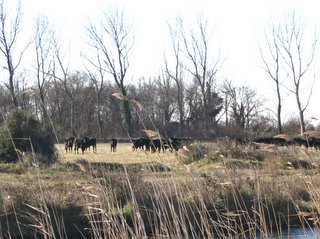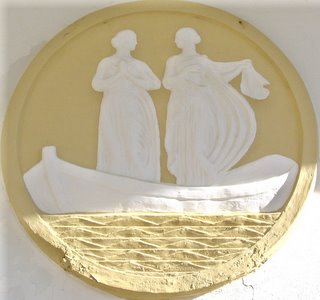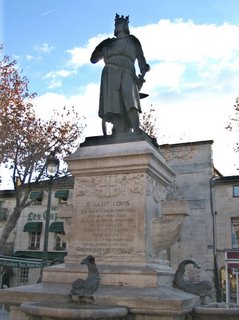It has been a bright, sunny, exhilarating but incredibly windy day with gusts of the Mistral of up to 100 kilometres an hour according to the French meteo. The lady running this campsite says that when the wind blows it is for 3, 6, or 9 days at a time. So far we’ve had 2 so she is hoping it will be a short wind. As we will have moved on we will probably never know. Throughout the day Ian has been regularly popping outside of Modestine into the howling wind to take photographs. This evening Jill is concerned to see the way his gaze sometimes strays thoughtfully to our scissors as he rubs his left ear, glowing red from the wind. If his photos were as good as Van Gogh’s paintings such eccentricities as missing ears could perhaps be forgiven.
Having allowed Ian to indulge in culture for the last few days, this morning Jill insisted it was her turn and she wanted to see the wild horses, black bulls and pink flamingos of the Camargue. Ian proved himself a complete liability as a travelling companion-cum-navigator by photographing the Roman aqueduct on the traffic island at Arles through the car window instead of telling Jill which exit she needed! Fortunately he thought the photo worth the nagging.
 Roman aqueduct on the roundabout at Pont de Crau, Arles
Roman aqueduct on the roundabout at Pont de Crau, ArlesThe Camargue is vaguely like a cross between the Norfolk Broads and the Romney Marshes with attitude! One major difference is that rice is grown in the Camargue which helps to remove surplus salt from the soil. It is an area of long straight flat roads with dykes for flood protection from the Rhone, which splits into two distinct arms, plus a network of streams and rivulets creating an extensive wetland of marshes, canals, salt meadows and reed-beds.
 Side road through the Camargue
Side road through the Camargue Drainage channel and reed-beds, the Camargue
Drainage channel and reed-beds, the CamargueThe area is a massive nature reserve for over-wintering birds with huge flocks of waterfowl on the enormous Etang du Vaccares. Turning to the minor roads we travelled along deserted, badly metalled routes between the reed beds where we disturbed a large white crane and later a huge and scruffy water rodent known here as a ragondin (we don’t have a dictionary so if anyone knows the English for this please let us know.) To our great delight, we even saw some wild flamingos feeding at a distance amongst the reeds across the marshes and fought over who should have first go of the binoculars.
 Etang du Vaccares, the Camargue
Etang du Vaccares, the Camargue Etang du Vaccares, the Camargue
Etang du Vaccares, the CamargueAll the guidebooks show white horses of the Camargue cantering through water, throwing up showers of spray from their hooves. The books also show fierce black bulls which are specially bred here for the arenas of Arles and Nîmes, or released into the local towns during summer festivals. White horses and black bulls we found in abundance, but they all had their heads down against the wind, busy chomping their way across the Camargue and not looking very wild at all. Ian did his best to antagonise the bulls for a photo-shot but they were having none of it.
 White horses of the Camargue
White horses of the Camargue Black bulls of the Camargue
Black bulls of the CamargueWe gradually made our way down to Saintes Maries de la Mer at the furthest possible point into the sea. Here, according to local legend, the two St. Marys – Mary Magdalene and Mary, mother of James and John, together with their black servant Sara - landed in a boat and set about converting the people of Provence to Christianity. One of them died and is supposed to be buried here. Their servant Sara is also buried here and a statue to her is in the church.
 Church of Saintes Maries de la Mer
Church of Saintes Maries de la Mer The two Saintes Maries de la Mer – as they appear on the town’s arms
The two Saintes Maries de la Mer – as they appear on the town’s armsApart from this unusual snippet, the town appears to be just another very pleasant, Mediterranean seaside holiday town. It is clean and white with lovely sandy beaches and with a little less wind, even today, would have been perfect for a stroll on the beach in the bright sunshine.
With half an eye for somewhere to sleep tonight we investigated the Aire de Camping Cars run by the municipality. It is quite huge with one turkish loo, a cold tap and waste disposal facilities. Probably this is sufficient for the big, self-contained monsters Modestine hangs around with, but her occupants need a few more comforts and facilities during the winter. There were at least 50 gleaming white kings of the road here and probably 47 of them were Italian with three token Dutch, Belgian and German vehicles. In the streets of the town we heard more Italian than French being spoken! We are puzzled as to why they have all congregated here. Do they live in Northern Italy and come to see the Roman remains as it is nearer than Rome? It is actually not far from Italy here by the motorway.
We had a plan B up our sleeve for tonight so headed on to Aigues-Mortes, an amazing fortress of a town set amidst the marshes of the flat countryside of the Rhône Delta. Constructed by Louis XI in the 13th Century as a major seaport, it was from here that he embarked on his 7th and 8th crusades in 1248 and 1270 respectively. (He had to cut short his holy work and return from the 7th one because his mum died and he managed to die from the plague on the 8th.) Louis was later canonised and known as St. Louis. How trundling off to the Orient and massacring people simply because they hold different views on religion qualifies one for canonisation is something we do not appreciate. Certainly the warrior-like statue to him in the town square is anything but saintly.
 Statue of St. Louis, Aigues-Mortes
Statue of St. Louis, Aigues-Mortes At the time of Louis’ crusades the town stood on the shores of the Mediterranean. Today the river estuary has silted up and changed course so many times Aigues-Mortes now stands eight kilometres inland. It has perfectly preserved or restored city walls surrounding a smart tourist town of clean bright houses, expensive patisseries and chocolateries and uncomfortable cobbled streets. The church where King Louis prayed before setting off on his killing sprees is very pleasant. The windows are all very modern stained glass completely out of keeping with the rest of the building and looking like design projects set for the local primary school. Most of the statues and paintings are also very modern but somehow everything contrasted to mutual advantage.
 Seaward ramparts, now high an dry at Aigues-Mortes
Seaward ramparts, now high an dry at Aigues-Mortes  One of the entrance gates to Aigues-Mortes
One of the entrance gates to Aigues-Mortes  Entrance through to exit at Aigues-Mortes
Entrance through to exit at Aigues-Mortes  Petanque is now played where crusaders gathered at Aigues-Mortes
Petanque is now played where crusaders gathered at Aigues-Mortes  The church at Aigues-Mortes
The church at Aigues-Mortes  Tour de Constance, Aigues-Mortes. Built as a lighthouse and later used as a prison for Protestants
Tour de Constance, Aigues-Mortes. Built as a lighthouse and later used as a prison for Protestants Such relentless wind – somewhat reminiscent of winter on Dartmoor – is quite exhausting. So we were happy to return to Modestine and set off to locate this campsite while there was still sufficient daylight. When we arrived nobody was around and we were greeted by a snarling rottweiler. However, we didn’t fancy driving a further twenty kilometres on to the site we used in Nîmes a week ago, so we ignored the dog and settled ourselves onto the site and hooked up to electricity. This is vital to us and worth any price as you can imagine. Later we located the pleasant and helpful site owner and paid the mere 12 euros required for security and warmth in this wintry climate. Prices vary considerably for much the same thing. Last night cost us 18 euros and our five days at the excellent site in Avignon cost 16.50 euros a night.
Wednesday 4th January 2006, Ambre-les-Espagnolettes
When Ian rang Colin and Jenny from the camp site this morning to warn them we would be returning today, they announced they were planning to move on themselves for a few days, following in our footsteps and visiting Aigues-Mortes. So we probably passed each other travelling in opposite directions!
The wind was still blowing strongly as we travelled down to the coast through the saltwater marshes and shallow lakes of the edge of the Camargue that skirt Montpellier to the south. The Mistral must be a very localised wind however because we soon left it behind, leaving us with warm sunshine and a beautiful day more reminiscent of May than January. It is astonishing the variety of temperatures and weather conditions we have experienced in such rapid succession recently.
We had read somewhere about the coastal town of la Grande Motte which was constructed on the beach amidst the wetlands of the Petit Camargue as a tourist paradise in 1967. According to the article, it has since aged as gracefully as a bean-bag of the same era. Having spent weeks visiting mediaeval towns steeped in history we were intrigued to see just how brash and horrid this place could be. In the event we found it a delightful, bright, clean sunny place with attractive public gardens and wide boulevards lined by palm trees and pines. The town still looks striking forty years on. Because it was planned as an entity rather than developing piecemeal as most French towns have done, there is nothing to jar and buildings that would look hideous elsewhere, actually show to great advantage here. The designers obviously had a lot of fun building pyramidal blocks of flats in white concrete, each apartment offering views of the sea and having a sun terrace on the roof of the apartment below. Instead of appearing deserted and shuttered like the comparable Cap D’Agde, over the winter, the flats looked occupied and cheerful. People are permanently resident in the town which had a shopping and commercial complex with a library and cultural centre just back from the seafront. The seafront itself has a broad clean promenade with views across the water to le Grau-du-Roi silhouetted on the skyline. A short stroll along the beach brought us to the harbour, full of smart yachts and motor boats. There is a casino and several enticing cafes, bars and restaurants, all with sheltered terraces bathed in warm bright sunshine. Here we basked in the unaccustomed warmth, enjoying coffee and watching the gentle waves on the sandy beach. Days like this really are different from January in England, but there have been less of them so far than we had expected.
 Egg boxes or funky design? La Grande Motte
Egg boxes or funky design? La Grande Motte From the seafront at La Grande Motte
From the seafront at La Grande Motte Along the promenade. La Grande Motte
Along the promenade. La Grande Motte 1960s concrete chic. La Grande Motte
1960s concrete chic. La Grande Motte The marina, La Grande Motte
The marina, La Grande Motte I do like to be beside the seaside. La Grande Motte
I do like to be beside the seaside. La Grande MotteThere was still much to explore on our way home, so we left la Grande Motte and continued along the narrow dyke of land separating the sea from the shallow lagoons behind. This is a very pleasant and fascinating landscape. The bright attractive city of Montpellier spreads out along the perimeter of the wide flat marshland where hundreds of sea birds feed, the sunlight reflecting from the surrounding water. At last we saw flamingos properly, in groups of about a dozen gangly pink birds, mostly standing on one long red leg, their necks weirdly twisted into their feathers, sound asleep in a few inches of salty water. Others were busy feeding on the tons of shellfish to be found in the lagoons. They needed to use both their rhubarb-stick legs to stir-up the mud as their upside down heads swing back and forth, their strong beaks just below the surface. They were fascinating to watch through our binoculars. We don’t know if they breed here or just over-winter. We thought they came from Africa.
 Flamingos sleeping with Montpellier behind
Flamingos sleeping with Montpellier behind  Pretty flamingos on the Etang de Pérols
Pretty flamingos on the Etang de PérolsWe continued westwards following the coast, eventually stopping behind the sand-dunes where we made mugs of tea and carried then down onto a completely deserted sandy beach that stretched away for miles in either direction.
 On the beach near Carnon-Plage
On the beach near Carnon-Plage Ian makes a point
Ian makes a point Just ‘cos we liked the picture and to prove the beach was empty
Just ‘cos we liked the picture and to prove the beach was empty Britain’s great white hope!
Britain’s great white hope!Eventually we reached Sète. We had visited this previously so now we felt on the home stretch. Rather than following the dyke 20 kilometres along between the sea and the Bassin de Thau, we turned inland travelling around the inside edge of the vast lake, stopping to look at the little town of Mèze with its front onto the water and its harbour of small fishing boats. The lagoon is used extensively for ostréiculture (the farming of oysters) as well as other shellfish such as cockles and mussels alive alive oh! The entire area is pervaded by the strong smell of decomposing seafood.
 The harbour at Mèze
The harbour at Mèze A distant view of the parc à huîtres (oyster park) at Mèze
A distant view of the parc à huîtres (oyster park) at MèzeAs the sun faded and the chill of the evening began we passed Béziers and were soon back in Ambre. It was lovely to be “home” and have room to stretch! Our fellow house guests had departed leaving everything so clean and tidy it is hard to believe they were even here!
